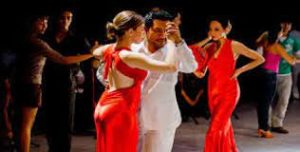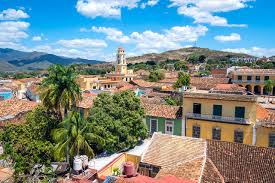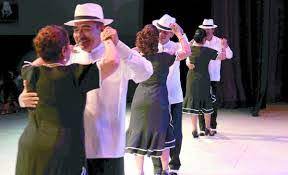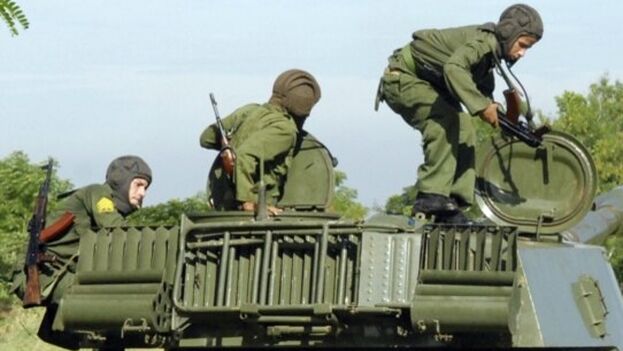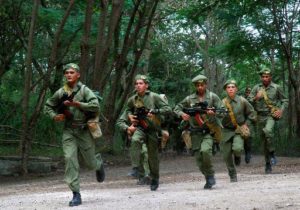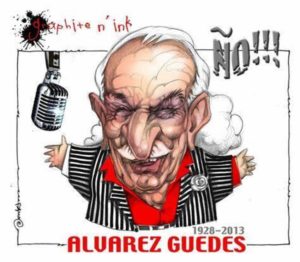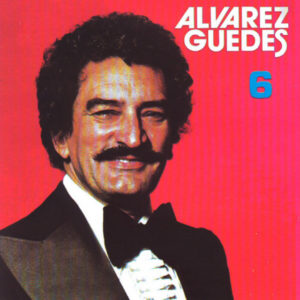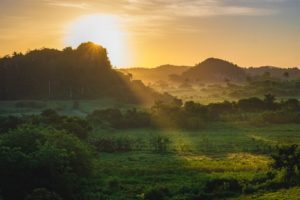TODAY, AFTER 150 YEARS, THE CUBAN DANZÓN IS STILL ALIVE. PHOTOS/VIDEOS
Danzón is the official musical genre and dance of Cuba. It is also an active musical form in Mexico and is much loved in Puerto Rico as well. The Danzón Cubano is a slow, formal partner dance, requiring set footwork around syncopated beats, and incorporating elegant pauses while the couples stand listening to virtuoso instrumental passages, as characteristically played by a charanga or típica ensemble.
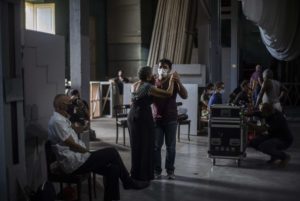
A couple dance danzón during a rehearsal with the Failde Orchestra in Matanzas, Cuba, Saturday, Oct. 2, 2021. Danzón started in the city in the late 1800s and became the national dance of Cuba, spreading to other countries in the region. (AP Photo/Ramón Espinosa)
The danzón evolved from the Cuban contradanza, or habanera (‘Havana-dance’). The contradanza, which had English and French roots in the country dance and contradense, was probably introduced to Cuba by the Spanish, who ruled the island for almost four centuries (1511–1898), contributing many thousands of immigrants. It may also have been partially seeded during the short-lived British occupation of Havana in 1762, and Haitian refugees fleeing the island’s revolution of 1791–1804 brought the French-Haitian kontradans, contributing their own Creole syncopation.
In Cuba, the dances of European origin acquired new stylistic features derived from African rhythm and dance to produce a genuine fusion of European and African influences. African musical traits in the danzón include complex instrumental cross-rhythms, expressed in staggered cinquillo and tresillo patterns.
 VIDEOS- DANCING THE CLASSIC DANZON CUBANO..
VIDEOS- DANCING THE CLASSIC DANZON CUBANO..
A JOURNEY THROUGH THE HISTORY OF THE CUBAN DANZÓN
Let’s place the old danzón genre in Matanzas, Cuba: A man in a white guayabera approaches a woman and stretches out his hand, palm up, inviting her to dance. She stands up and waves her fan. On the dance floor, they get closer.
Such a scene at the end of the 19th century in Cuba was scandalous in some circles. It was also a new musical genre, the danzón.
Now some danzón scores from that time that were lost in the archives in the Cuban city of Matanzas have been rediscovered. Four of them were recently recorded by the Failde Orchestra, highlighting what became the national dance of Cuba and later spread to other countries in the region.
Recording the scores is important so that society today and future generations ″have a reference for what was their identity,″ said musicologist María Victoria Oliver.
She and colleagues found the scores after checking the archives of several Matanzas institutions, including the provincial library, the concert band, and the local museum. Even though the danzón started in the city in 1879, there were few written records of it until the early 20th century.
The 16 pieces that were discovered included both danzones and danzonetes, the latter being a variation that incorporated vocal interpretation and other changes. Several are part of the album “Joyas Inéditas,” or ″Unpublished Jewels.″ It is produced by the Egrem label, with arrangements and performance by the Failde Orchestra, led by flutist Ethiel Failde, a great-great-grandnephew of the creator of danzón.
“It is a great joy to be able to find unpublished scores that allow us to demonstrate an evolution of the genre,” said Oliver. The work was cumbersome and included “translation” of the scores since the 19th-century writing method was different from that of today and arrangements had to be made to update the music without losing its essence.
Located 100 kilometers (60 miles) east of Havana, Matanzas had electricity even before the capital, thanks to its huge bay, a transit point for Cuban sugar exports as well as the arrival of enslaved people to work on sugar plantations in defiance of European bans on slavery.
The city retains vestiges of the sugar boom: stately mansions and other old homes with wood-lined walls and high ceilings that hosted the emergence of danzón, a precursor of other musical genres such as the mambo or chachachá.
The danzón spread to the Dominican Republic and Mexico, where it has passionate followers today.
MEMORIES OF THE ORIGINAL DANZONES
The first danzón had origins in the old Spanish contradanzas. It was premiered by Miguel Failde and his orchestra from Matanzas in 1879 and titled “The Heights of Simpson.”
The album “Joyas Inéditas,” recorded in February, includes the rescued danzones “El Naranjero”, “Cuba Libre”, “A La Habana me Voy” and “Nievecita” by Miguel Failde himself.
“I am happy because it will be my tribute to Miguel Failde,” said descendant Ethiel Failde, who now conducts the orchestra, made up of artists mostly in their 20s.
Ethiel Failde said he “fell in love” with danzón when his elementary school teacher taught him to dance and then took it up as a professional musician.
“Joyas Inéditas” was launched in two formats: one standard with a typical acrylic case and the other inserted in a wooden box that includes five Cuban cigars.
“It is one of the Cuban genres that has lasted the longest,″ Failde said. ″150 years later, it’s still alive.″
HOY, DESPUÉS DE 150 AÑOS, EL DANZÓN CUBANO SIGUE VIVO. PHOTOS/VIDEOS
El danzón es el género musical y la danza oficial de Cuba. También es una forma musical activa en México y también es muy apreciada en Puerto Rico. El Danzón Cubano es un baile lento y formal en pareja, que requiere un juego de pies en torno a ritmos sincopados e incorpora pausas elegantes mientras las parejas escuchan pasajes instrumentales virtuosos, interpretados característicamente por una charanga o conjunto típico.
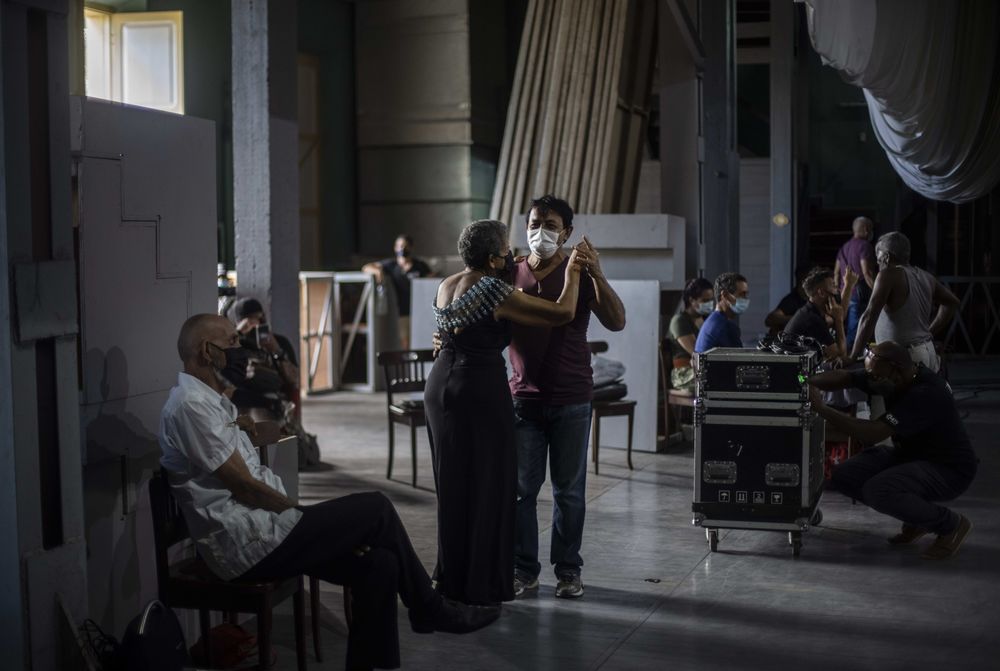
Una pareja baila danzón durante un ensayo con la Orquesta Failde en Matanzas, Cuba, el sábado 2 de octubre de 2021. El danzón comenzó en la ciudad a fines del siglo XIX y se convirtió en el baile nacional de Cuba, extendiéndose a otros países de la región. (Foto AP / Ramón Espinosa)
El danzón evolucionó de la contradanza cubana o habanera (‘danza de la Habana’). La contradanza, que tenía raíces inglesas y francesas en la danza del campo y la contradanse, probablemente fue introducida en Cuba por los españoles, que gobernaron la isla durante casi cuatro siglos (1511-1898), aportando muchos miles de inmigrantes. También puede haber sido parcialmente sembrado durante la breve ocupación británica de La Habana en 1762, y los refugiados haitianos que huían de la revolución de la isla de 1791–1804 trajeron consigo a los kontradans franco-haitianos, contribuyendo con su propia síncopa criolla.
En Cuba, las danzas de origen europeo adquirieron nuevos rasgos estilísticos derivados del ritmo y la danza africanos para producir una genuina fusión de influencias europeas y africanas. Los rasgos musicales africanos en el danzón incluyen complejos ritmos cruzados instrumentales, expresados en patrones escalonados de cinquillo y tresillo.
UN VIAJE TRAS LA HISTORIA DEL DANZÓN CUBANO
Coloquemos el viejo género del danzón en Matanzas, Cuba: Un hombre con una guayabera blanca se acerca a una mujer y extiende la mano, palma hacia arriba, invitándola a bailar. Se pone de pie y agita su abanico. En la pista de baile, se acercan.
 VIDEOS – BAILANDO DANZON CUBANO..
VIDEOS – BAILANDO DANZON CUBANO..
Tal escena a fines del siglo XIX en Cuba fue escandalosa en algunos círculos. También era un nuevo género musical, el danzón.
Ahora se han redescubierto algunas partituras de danzón de esa época que se perdieron en los archivos de la ciudad cubana de Matanzas. Cuatro de ellos fueron grabados recientemente por la Orquesta Failde, destacando lo que se convirtió en el baile nacional de Cuba y luego se extendió a otros países de la región.
Grabar las partituras es importante para que la sociedad de hoy y las generaciones futuras ″ tengan un referente de cuál fue su identidad ″, dijo la musicóloga María Victoria Oliver.
Ella y sus colegas encontraron las partituras después de revisar los archivos de varias instituciones de Matanzas, incluida la biblioteca provincial, la banda de conciertos y el museo local. A pesar de que el danzón comenzó en la ciudad en 1879, hubo pocos registros escritos hasta principios del siglo XX.
Las 16 piezas que se descubrieron incluían tanto danzones como danzonetes, siendo este último una variación que incorporó interpretación vocal y otros cambios. Varios forman parte del disco “Joyas Inéditas”, o ″ Joyas inéditas ″. Está producido por el sello Egrem, con arreglos e interpretación de la Failde Orchestra, dirigida por el flautista Ethiel Failde, tatarabuelo del creador de danzón.
“Es una gran alegría poder encontrar partituras inéditas que nos permitan demostrar una evolución del género”, dijo Oliver. El trabajo era engorroso e incluía la “traducción” de las partituras ya que el método de escritura del siglo XIX era diferente al actual y había que hacer arreglos para actualizar la música sin perder su esencia.
Ubicada a 100 kilómetros (60 millas) al este de La Habana, Matanzas tenía electricidad incluso antes que la capital, gracias a su enorme bahía, punto de tránsito de las exportaciones de azúcar cubana, así como a la llegada de esclavos para trabajar en las plantaciones de azúcar desafiando las prohibiciones europeas. sobre la esclavitud.
La ciudad conserva vestigios del boom azucarero: casonas señoriales y otras casas antiguas con muros revestidos de madera y techos altos que acogieron el surgimiento del danzón, precursor de otros géneros musicales como el mambo o el chachachá.
El danzón se extendió a República Dominicana y México, donde hoy cuenta con apasionados seguidores.
MEMORIAS DE LAS DANZONES ORIGINALES
El primer danzón tuvo su origen en las antiguas contradanzas españolas. Fue estrenada por Miguel Failde y su orquesta de Matanzas en 1879 y se tituló “Las alturas de Simpson”.
 VIDEOS- DANZON “Las Alturas de Simpson”..
VIDEOS- DANZON “Las Alturas de Simpson”..
El disco “Joyas Inéditas”, grabado en febrero, incluye los danzones rescatados “El Naranjero”, “Cuba Libre”, “A La Habana me Voy” y “Nievecita” del propio Miguel Failde.
“Estoy feliz porque será mi homenaje a Miguel Failde”, dijo el descendiente Ethiel Failde, quien ahora dirige la orquesta, compuesta en su mayoría por artistas de 20 años.
Ethiel Failde dijo que se “enamoró” del danzón cuando su maestra de primaria le enseñó a bailar y luego lo tomó como músico profesional.
“Joyas Inéditas” se lanzó en dos formatos: uno estándar con una típica caja acrílica y el otro insertado en una caja de madera que incluye cinco puros cubanos.
“Es uno de los géneros cubanos que más tiempo ha durado”, dijo Failde. ″ 150 años después, todavía está vivo ″.
Agencies/ AP/ Andrea Rodríguez/ Internet Photos/ YouTube/ Arnoldo Varona/ www.TheCubanHistory.com
THE CUBAN HISTORY, HOLLYWOOD.



